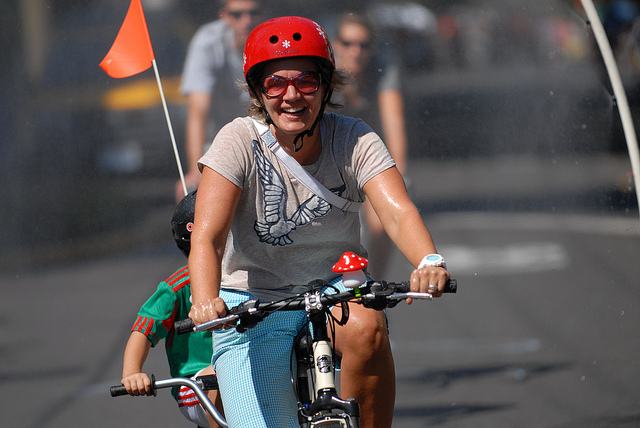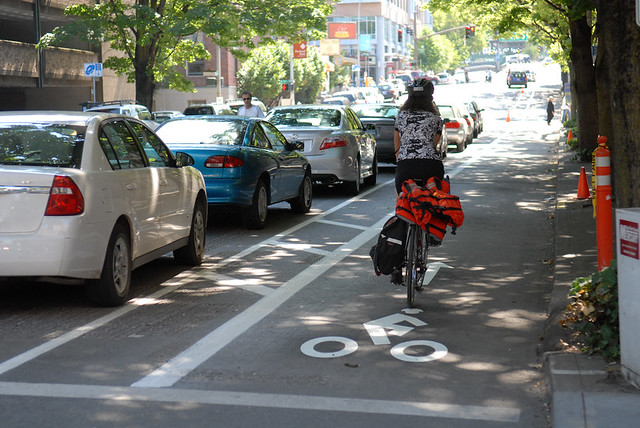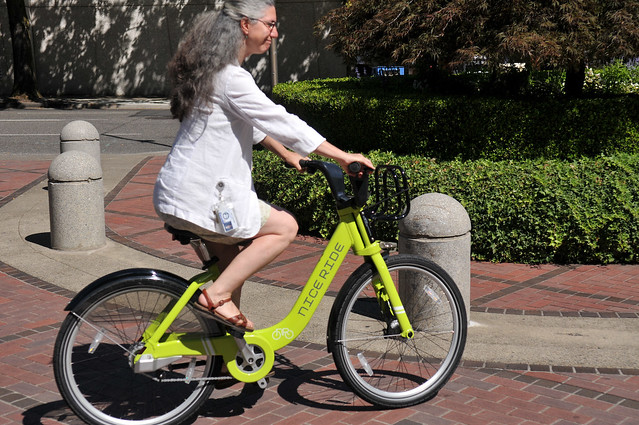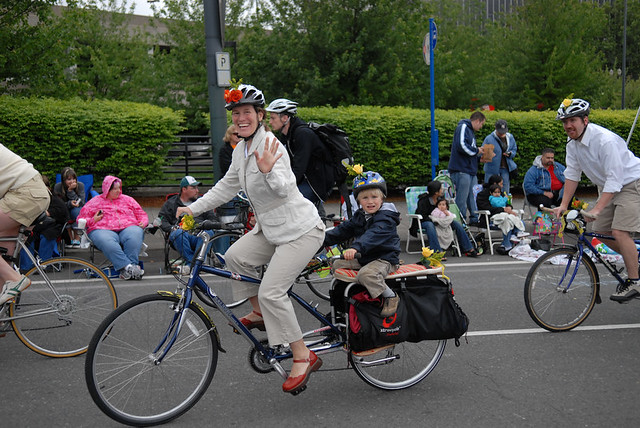Even in Portland, people who really ought to know better (links to FB) still claim now and then that biking is a thing for young dudes.
Still, in a town where only 31 percent of people on bikes tend to be female (it’s about 25 percent nationally) we’ve got a long way to go until, as in Germany or the Netherlands, our biking population is evenly split by gender. Portland’s failure to change this ratio for 10 years can be discouraging to people who think everyone deserves to feel welcome on a bike.
That’s why there’s a lot to celebrate in a new report by the League of American Bicyclists that rounds up dozens of statistics about women and bikes. Culled from industry reports, political polls and academic studies, a few of the report’s figures are pretty surprising…
1) All U.S. growth in occasional bike riding seems to be happening among women.
Here’s the only fact in this study that really knocked my socks off: between 2003 and 2012, though the national bike commuting rate has been rising rapidly among both men and women, the number of American men and boys who ride at least occasionally (at least six times per year) has completely flatlined. A National Sporting Goods Association web survey of 38,000 households found that the number of males who ride is stuck at 20.2 million, despite national population growth of 8 percent over the same period.
Meanwhile, the number of women and girls who say they ride a bike at least six times a year is up 20 percent, to 19.1 million.
League spokeswoman Carolyn Szczepanski described this as “one of the most surprising things I found,” and I agree. For Portland, this should be a reminder that a bike network doesn’t just serve people who spend a lot of time with it; it needs to be intuitive to those who use it now and then.
2) There are business openings for bike shops that serve women better.
According to the Gluskin Townley Group’s 2012 American Bicyclist Survey, only 37 percent of women bought their current bike from a shop, compared to 48 percent of men.
Probably related: 89 percent of bike shop owners are men, according to a 2013 report for the National Bicycle Dealers Association. (Of bike shops, 33 percent are owned by a husband-wife team.) Though we have some great shops with women in charge (Coventry, Clever and Splendid Cycles come to mind), a lot of shops in Portland, whoever the owner, still feel like boys’ clubs when you walk in. You can call that a problem, but I call it an opportunity.
3) If we can safely separate bike and auto traffic, female biking is likely to rise.
Yesterday’s news that the federal government seems to be preparing to endorse cycle tracks is likely to boost the number of women in the saddle. While 13 percent of men say they’re “confident riding on all roads with traffic,” only 6 percent of women say the same. The national shift toward building physically separated cycle tracks, which has yet to take off in Portland, is in part a response to this gender gap, which was captured in a September 2012 poll by Princeton Survey Research Associates.
Portland’s network of off-street paths also has some glaring omissions, like the obvious lack of routes alongside the east side of the Willamette or Interstate 84.
If there’s an obvious reason why Portland’s bike gender gap has persisted for so long, this is it.
4) Public bikesharing tends to be a hit with women.
A study last year by Susan Shaheen of public bikesharing systems in North America found that 43 percent of all bikeshare members are female, far above the national norm for bike trips. If Alta Bicycle Share ever recruits the sponsors that’ll bring such a system to Portland, expect a similar trend here.
5) When biking gets beyond commuting, women win.
Like it or not, women in two-adult households tend to make twice as many trips as men to drop off or pick up children, according to a 2005 study, and women who bike are twice as likely as men who bike to use it for shopping and errands, a different study found. If we think these trends will continue, we should be making bikes and bikeways that people will use to carry both children and purchased goods.
This also means that if we increase the number of women on bikes, we’ll be strengthening the argument that good bike parking and access can be better for retailers than a few auto parking spaces.
6) Professional bike advocacy is doing OK at hiring women, less so at making them leaders.
I was pleased to learn that 45 percent of paid bike advocacy staff are female, but depressed to see that of 89 board members at the six biggest national bike advocacy groups, only 20 are women. Here in Portland, women are slightly less rare on the boards of the Bicycle Transportation Alliance and Community Cycling Center: they’re currently 9 in 28; both groups have had female executive directors in the past, though for the BTA it’s been a while.
Another notable stat from the report: women represent 22 percent of the Congressional Bike Caucus. That seems like a big imbalance … until you realize that women only represent 18 percent of Congress. Biking isn’t the only area where this country has a long way to go.
Want to talk more about these issues with like-minded advocates? Join a nationwide Twitter chat at 5 p.m. tomorrow (Friday, 8/9) by following and using the hashtag #womenbike.








